Experimental Investigation of Structural Response of Corrugated Steel Sheet Subjected to Repeated Impact Loading: Performance of LNG Cargo Containment System
Abstract
1. Introduction
2. Experiments
2.1. Test Specimen
2.2. Experimental Apparatus
2.3. Experimental Scenario
3. Results and Discussions
3.1. Effect of Impact Energy
3.2. Effect of the Number of Impacts
3.3. Application to Failure Analysis of Insulation Panel
4. Conclusions
- Temporal patterns measured in the experiment and actual sloshing test were compared. In the force profile, the ratio of rise time and duration is similar to the actual sloshing phenomenon, and thus the effectiveness of the impact test method was confirmed. The effect of the impact energy and the number of repetitions on reaction force time–history and deformation of primary barrier were investigated. As the repetitive impact was applied, the force profile changed to a uniform shape.
- Small corrugations have less impact resistance than large corrugations, but there was no significant difference in displacement increment for each corrugation. With repetitive impact loading, corrugation reached the collapse phase where it lies down on the bottom. When the corrugation collapses, the fulcrum phenomenon appears. If the collapsed primary barrier is subjected to a sloshing load, the plywood under the primary barrier can be damaged due to the geometric shape of the fulcrum concentrating the load.
- Experimental results of the primary barrier behavior under impact conditions are needed to perform LNG CCS assessment under sloshing with a probabilistic analysis. Given that it is very difficult to define failure of a thin-walled structure made of stainless steel through the experimental results, it is necessary to develop a computational analysis methodology based on failure theory in order to define failure criteria of the primary barrier under a sloshing load.
Author Contributions
Funding
Acknowledgments
Conflicts of Interest
References
- Det Norske Veritas. Classification Note 30.9: Sloshing Analysis of LNG Membrane Tanks; Det Norske Veritas: Oslo, Norway, 2014; pp. 1–98. [Google Scholar]
- Gavory, T.; De Seze, P.E. Sloshing in Membrane LNG Carriers and Its Consequences from a Designer’s Perspective. In Proceedings of the Nineteenth International Offshore and Polar Engineering Conference, Osaka, Japan, 21–26 July 2009. [Google Scholar]
- Noh, B.J.; Kim, W.S.; Kwon, S.H.; Chung, J.Y. Comparative Wet Drop Experiments of MARK III and KC-1 for membrane type LNG carriers. In Proceedings of the ASME 2009 28th International Conference on Ocean, Offshore and Arctic Engineering, Honolulu, HI, USA, 31 May–5 June 2009. [Google Scholar]
- Wang, K.S. Loss Prevention through Risk Assessment Surveys of LNG Carriers in Operation, under Construction, Conversion and Repair, BMT Marine & Offshore Surveys. Available online: http://www.bmtmarinerisk.com (accessed on 19 March 2019).
- Bogaert, H.; Kaminski, M.L.M.; Brosset, L. Full and large scale wave impact tests for a better understanding of sloshing: Results of the Sloshel project. In Proceedings of the ASME 2011 30th International Conference on Ocean, Offshore and Arctic Engineering, Rotterdam, The Netherlands, 19–24 June 2011. [Google Scholar]
- Chun, M.S.; Kim, M.H.; Kim, W.S.; Kim, S.H.; Lee, J.M. Experimental investigation on the impact behavior of membrane type LNG carrier insulation system. J. Loss. Prev. Process Ind. 2009, 22, 901–907. [Google Scholar] [CrossRef]
- Kim, S.K.; Lee, C.S.; Kim, J.H.; Kim, M.H.; Lee, J.M. Computational evaluation of resistance of fracture capacity for SUS304L of liquefied natural gas insulation system under cryogenic temperatures using ABAQUS user-defined material subroutine. Mater. Des. 2013, 50, 522–532. [Google Scholar] [CrossRef]
- Lee, C.S.; Cho, J.R.; Kim, W.S.; Noh, B.J.; Kim, M.H.; Lee, J.M. Evaluation of sloshing resistance performance for LNG carrier insulation system based on fluid-structure interaction analysis. Int. J. Nav. Archit. Ocean Eng. 2013, 5, 1–20. [Google Scholar] [CrossRef]
- Kim, J.H.; Kim, S.K.; Kim, M.H.; Lee, J.M. Numerical model to predict deformation of corrugated austenitic stainless steel sheet under cryogenic temperatures for design of liquefied natural gas insulation system. Mater. Des. 2014, 57, 26–39. [Google Scholar] [CrossRef]
- Lee, C.S.; Lee, J.M. Failure analysis of reinforced polyurethane foam-based LNG insulation structure using damage-coupled finite element analysis. Compos. Struct. 2014, 107, 231–245. [Google Scholar] [CrossRef]
- Lee, C.S.; Kim, M.S.; Park, S.B.; Kim, J.H.; Bang, C.S.; Lee, J.M. A temperature- and strain-rate-dependent isotropic elasto-viscoplastic model for glass-fiber-reinforced polyurethane foam. Mater. Des. 2015, 84, 163–172. [Google Scholar] [CrossRef]
- Andreaus, U.; Chiaia, B.; Placidi, L. Soft-impact dynamics of deformable bodies. Continuum Mech. Therm. 2013, 25, 375–398. [Google Scholar] [CrossRef]
- Andreaus, U.; Baragatti, P.; Placidi, L. Experimental and numerical investigations of the responses of a cantilever beam possibly contacting a deformable and dissipative obstacle under harmonic excitation. Int. J. Nonlinear Mech. 2016, 80, 96–106. [Google Scholar] [CrossRef]
- Lee, S.J.; Kim, M.H.; Lee, D.H.; Kim, J.W.; Kim, Y.H. The effects of LNG-tank sloshing on the global motions of LNG carriers. Ocean Eng. 2007, 34, 10–20. [Google Scholar] [CrossRef]
- Paik, K.J.; Carrica, P.M. Fluid-structure interaction for an elastic structure interacting with free surface in a rolling tank. Ocean Eng. 2014, 84, 201–212. [Google Scholar] [CrossRef]
- Paik, K.J.; Carrica, P.M.; Lee, D.; Maki, K. Strongly coupled fluid-structure interaction method for structural loads on surface ships. Ocean Eng. 2009, 36, 1346–1357. [Google Scholar] [CrossRef]
- Kim, S.Y.; Kim, Y.; Kim, K.H. Statistical analysis of sloshing-induced random impact pressures. Proc. Inst. Mech. Eng. Part M J. Eng. Marit. Environ. 2014, 228, 235–248. [Google Scholar] [CrossRef]
- Zhao, Y.; Chen, H.C. Numerical simulation of 3D sloshing flow in partially filled LNG tank using a coupled level-set and volume-of-fluid method. Ocean Eng. 2015, 104, 10–30. [Google Scholar] [CrossRef]
- Lafeber, W.; Brosset, L.; Bogaert, H. Elementary Loading Processes (ELP) involved in breaking wave impacts: Findings from the Sloshel project. In Proceedings of the Twenty-second International Offshore and Polar Engineering Conference, International Society of Offshore and Polar Engineers, Rhodes, Greece, 17–22 June 2012. [Google Scholar]
- Bunnik, T.; Huijsmans, R. Large scale LNG sloshing model tests. In Proceedings of the Seventeenth International Offshore and Polar Engineering Conference, International Society of Offshore and Polar Engineers, Lisbon, Portugal, 1–6 July 2007. [Google Scholar]
- Richardson, A.J.; Bray, W.H.; Sandström, R.E.; Lokken, R.T.; Danaczko, M.A. Advances in assessment of LNG sloshing for large membrane ships. In Proceedings of the 21st International Conference and Exhibit, Budapest, Hungary, 17–22 July 2005. [Google Scholar]
- Lugni, C.; Brocchini, M.; Faltinsen, O.M. Wave impact loads: The role of the flip-through. Phys. Fluids 2006, 18, 122101. [Google Scholar] [CrossRef]
- Kim, B.C.; Yoon, S.H.; Lee, D.G. Pressure resistance of the corrugated stainless steel membranes of LNG carriers. Ocean Eng. 2011, 38, 592–608. [Google Scholar]
- Kim, W.S.; Noh, B.J.; Lee, H.; Mravak, Z.; Lauzon, J.; Maguire, J.R.; Radosavljevic, D.; Kwon, S.H.; Chung, J.Y. Fluid-structure interaction modeling, relating to membrane LNG ship cargo containment system. In Proceedings of the Eighteenth International Offshore and Polar Engineering Conference, Vancouver, BC, Canada, 6–11 July 2008. [Google Scholar]
- Graczyk, M.; Moan, T. A probabilistic assessment of design sloshing pressure time histories in LNG tanks. Ocean Eng. 2008, 35, 834–855. [Google Scholar] [CrossRef]
- Park, W.S.; Yoo, S.W.; Kim, M.H.; Lee, J.M. Strain-rate effects on the mechanical behavior of the AISI 300 series of austenitic stainless steel under cryogenic environments. Mater. Des. 2010, 31, 3630–3640. [Google Scholar] [CrossRef]
- Huang, Z.Q.; Chen, Q.S.; Zhang, W.T. Pseudo-shakedown in the collision mechanics of ships. Int. J. Impact Eng. 2000, 24, 19–31. [Google Scholar] [CrossRef]
- Jones, N. Pseudo-shakedown phenomenon for the mass impact loading of plating. Int. J. Impact Eng. 2014, 65, 33–39. [Google Scholar] [CrossRef]
- Cho, S.R.; Truong, D.D.; Shin, H.K. Repeated lateral impacts on steel beams at room and sub-zero temperatures. Int. J. Impact Eng. 2014, 72, 75–84. [Google Scholar] [CrossRef]
- Ghajar, R.; Khalili, S.M.R.; Yarmohammad Tooski, M.; Alderliesten, R.C. Investigation of the response of an aluminium plate subjected to repeated low velocity impact using a continuum damage mechanics approach. Fatigue Fract. Eng. Mater. Struct. 2015, 38, 475–488. [Google Scholar] [CrossRef]
- Hooputra, H.; Gese, H.; Dell, H.; Werner, H. A comprehensive failure model for crashworthiness simulation of aluminium extrusions. Int. J. Crashworthines 2004, 9, 449–464. [Google Scholar] [CrossRef]
- Nam, A.W.; Choung, J. Prediction of failure strain according to stress triaxiality of a high strength marine structural steel. In Collision and Grounding of Ships and Offshore Structures; Amdahl, J., Ehlers, S., Leira, B.J., Eds.; CRC Press: Boca Raton, FL, USA, 2013; pp. 69–76. [Google Scholar]
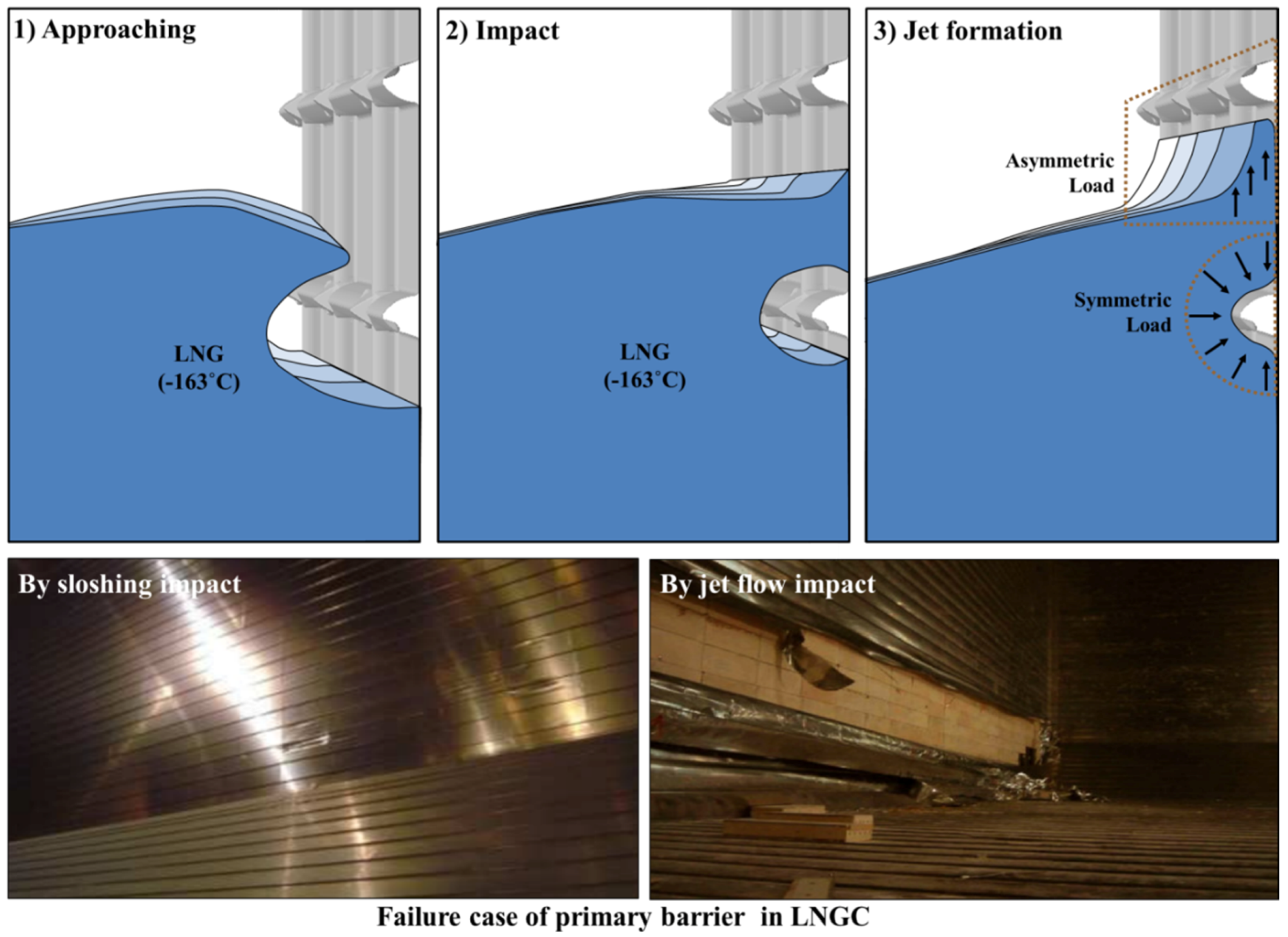
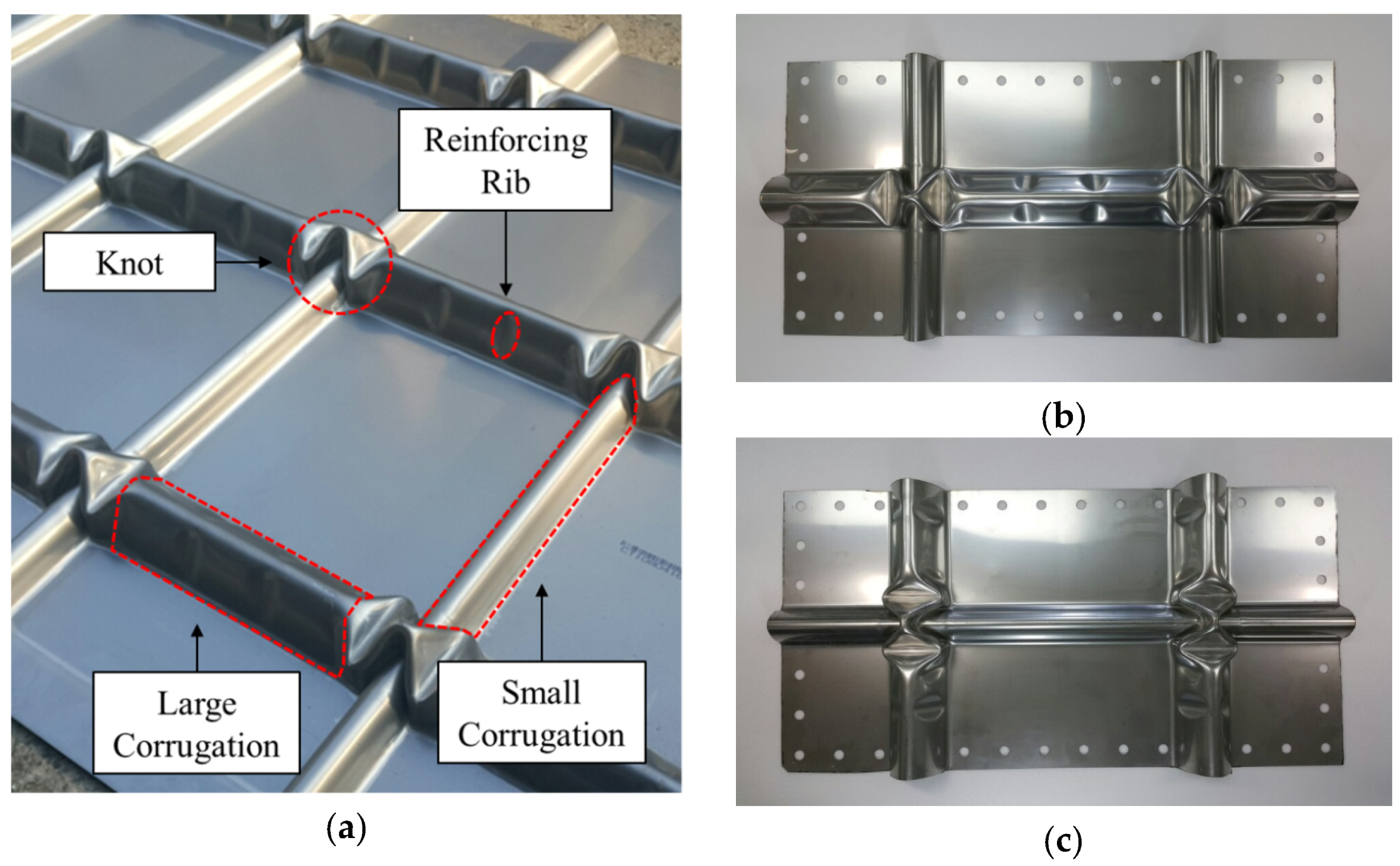
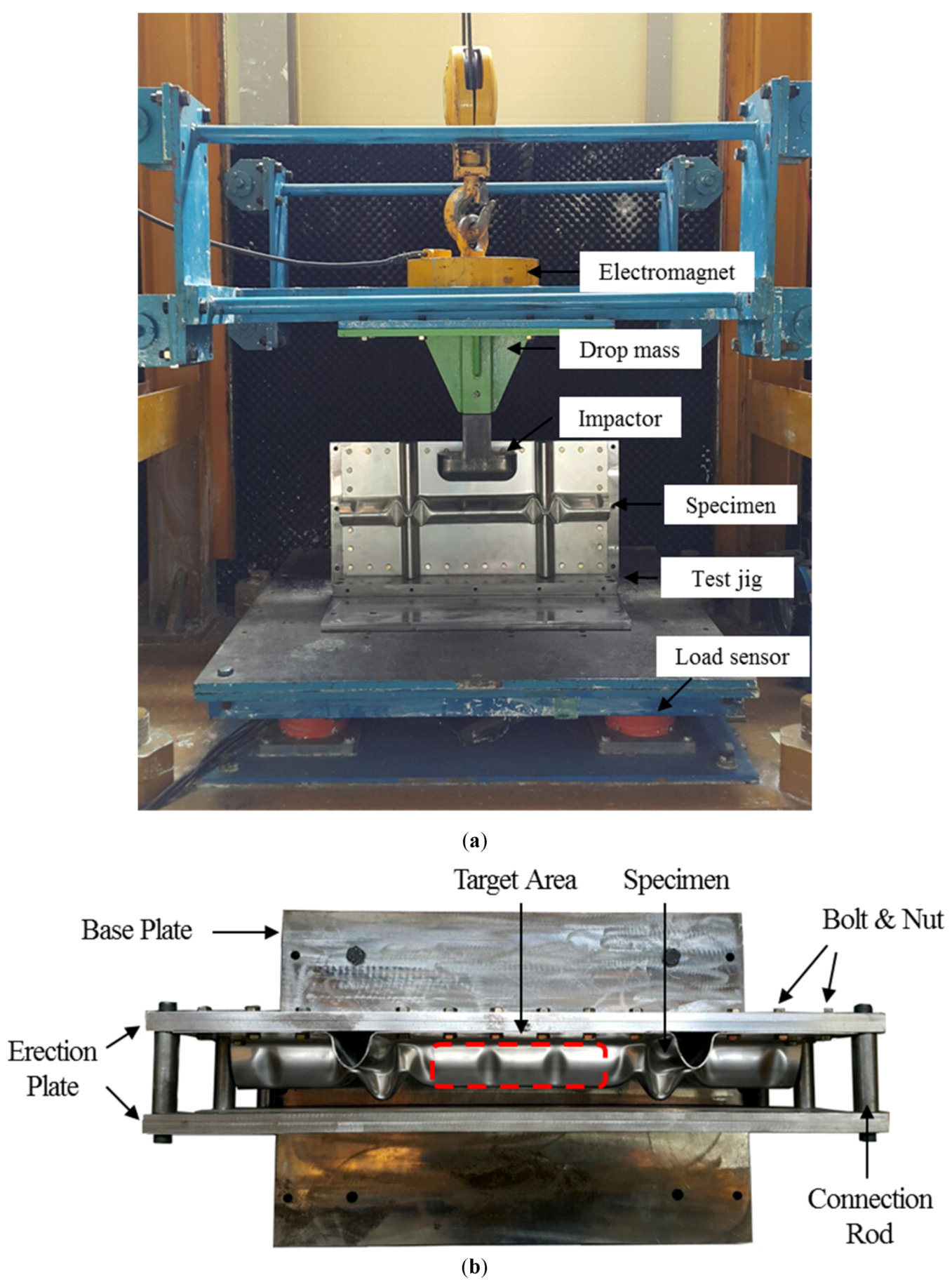
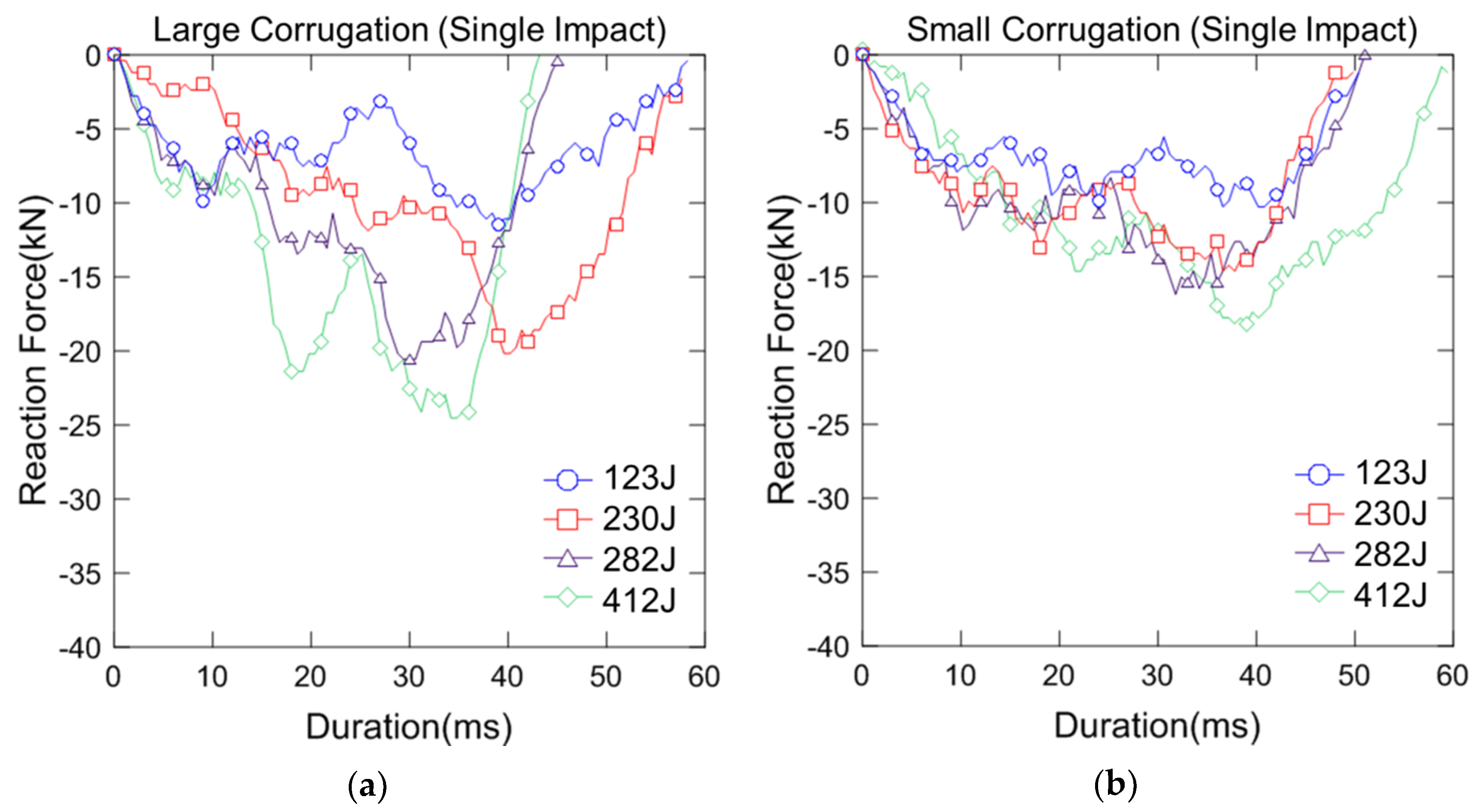
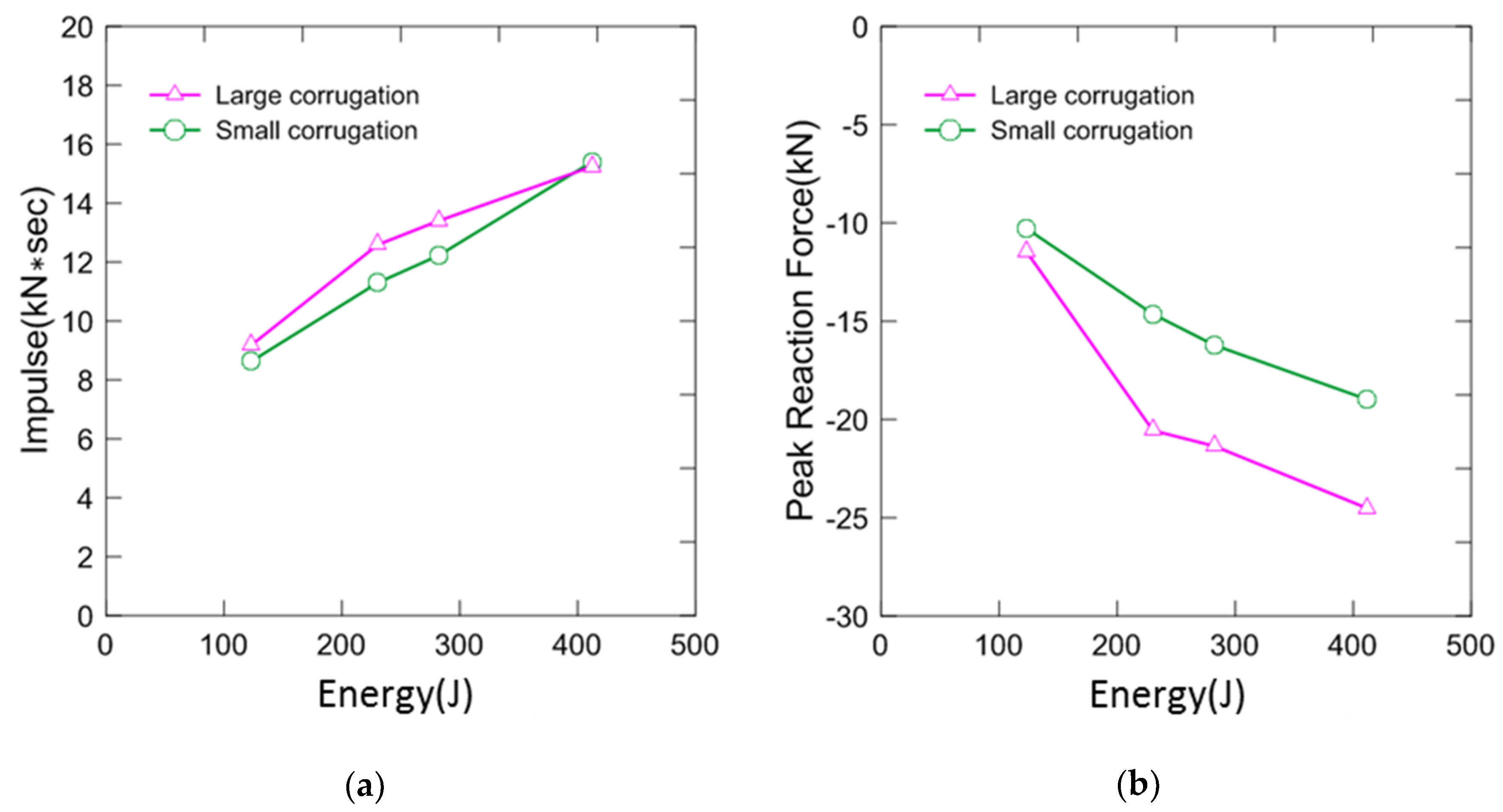
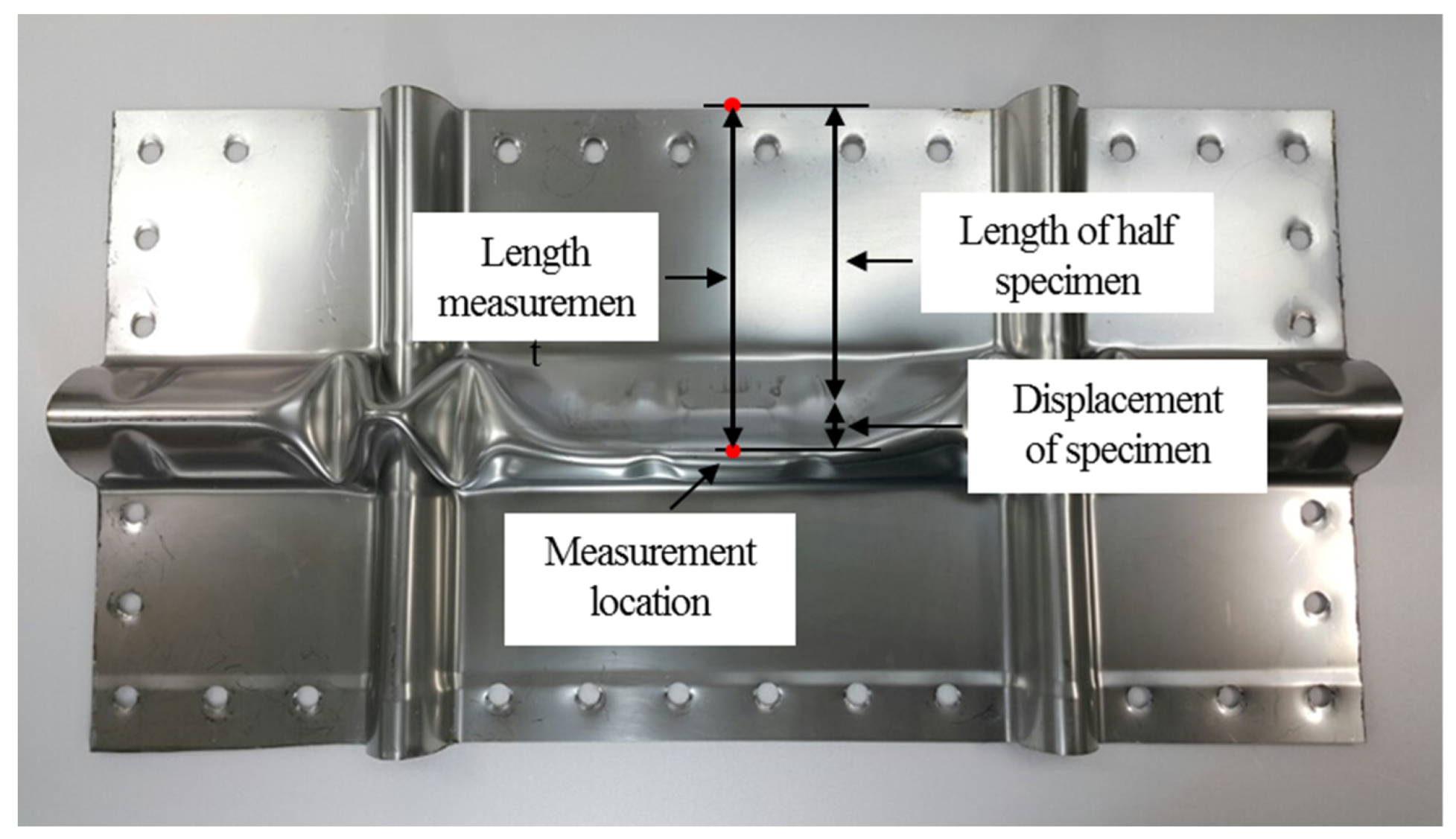
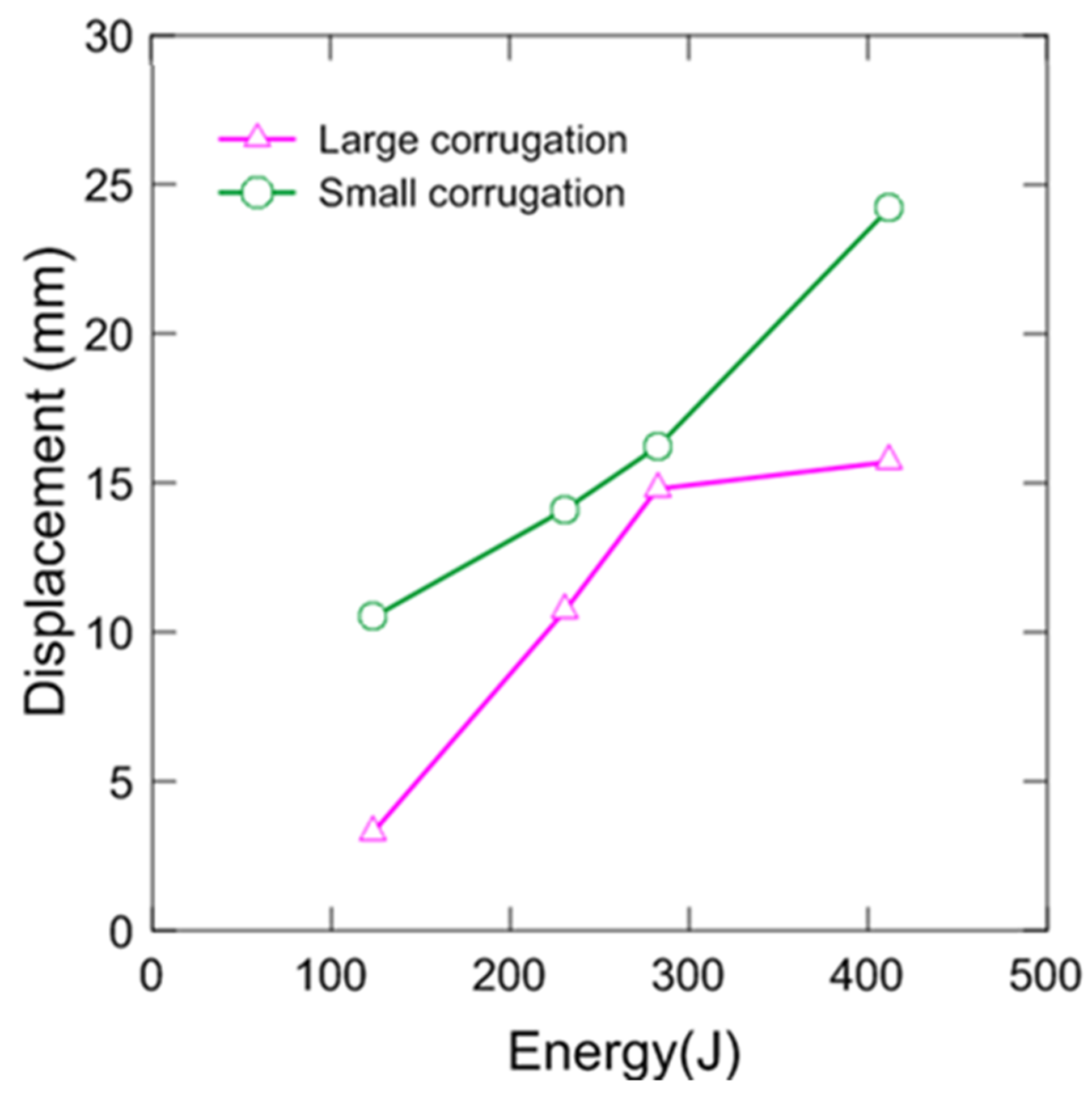
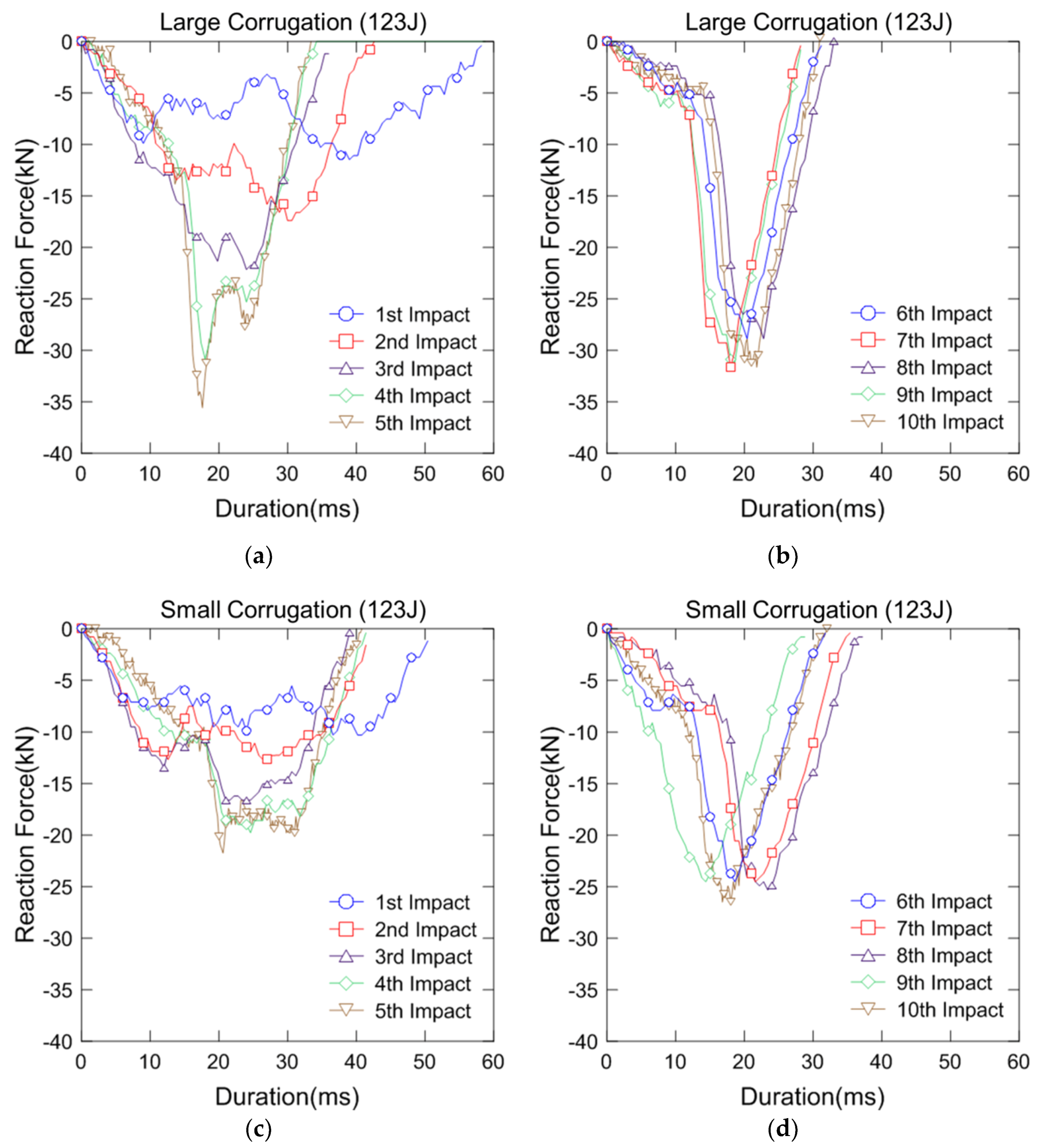


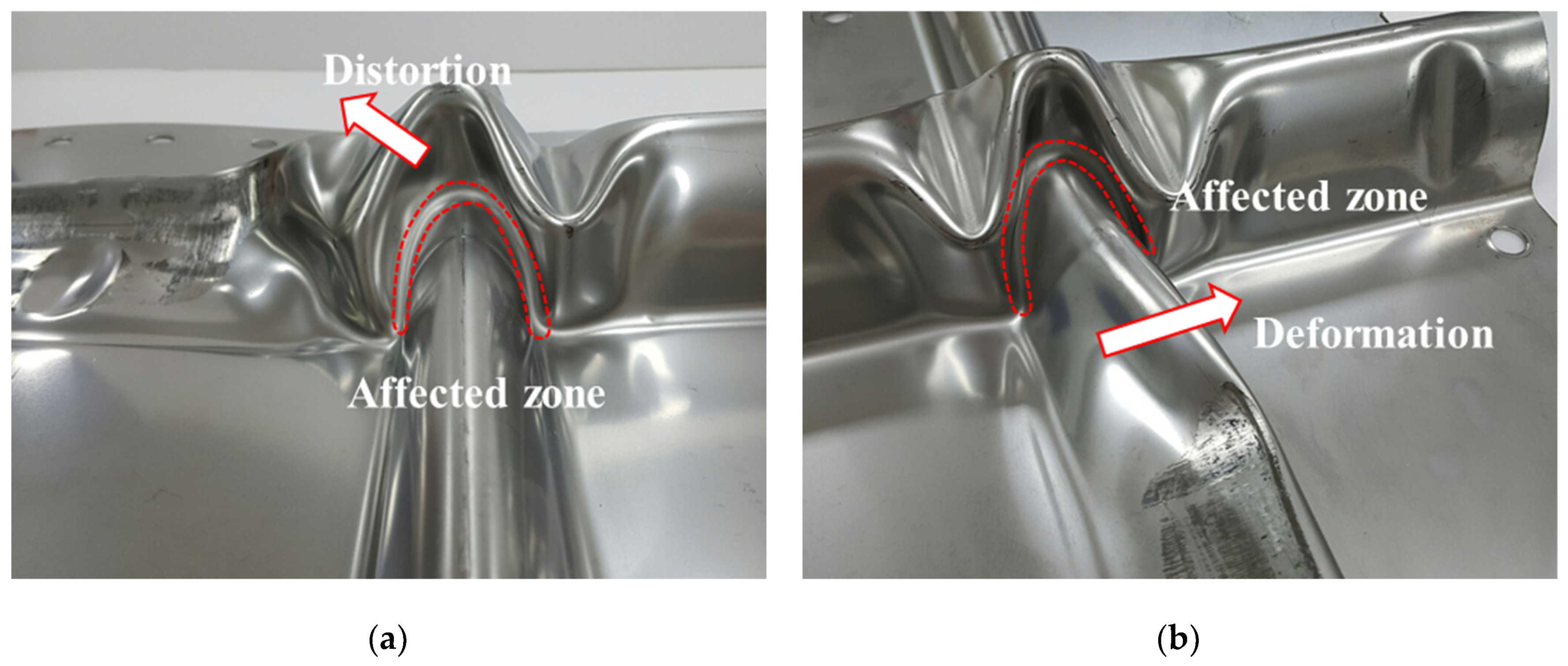
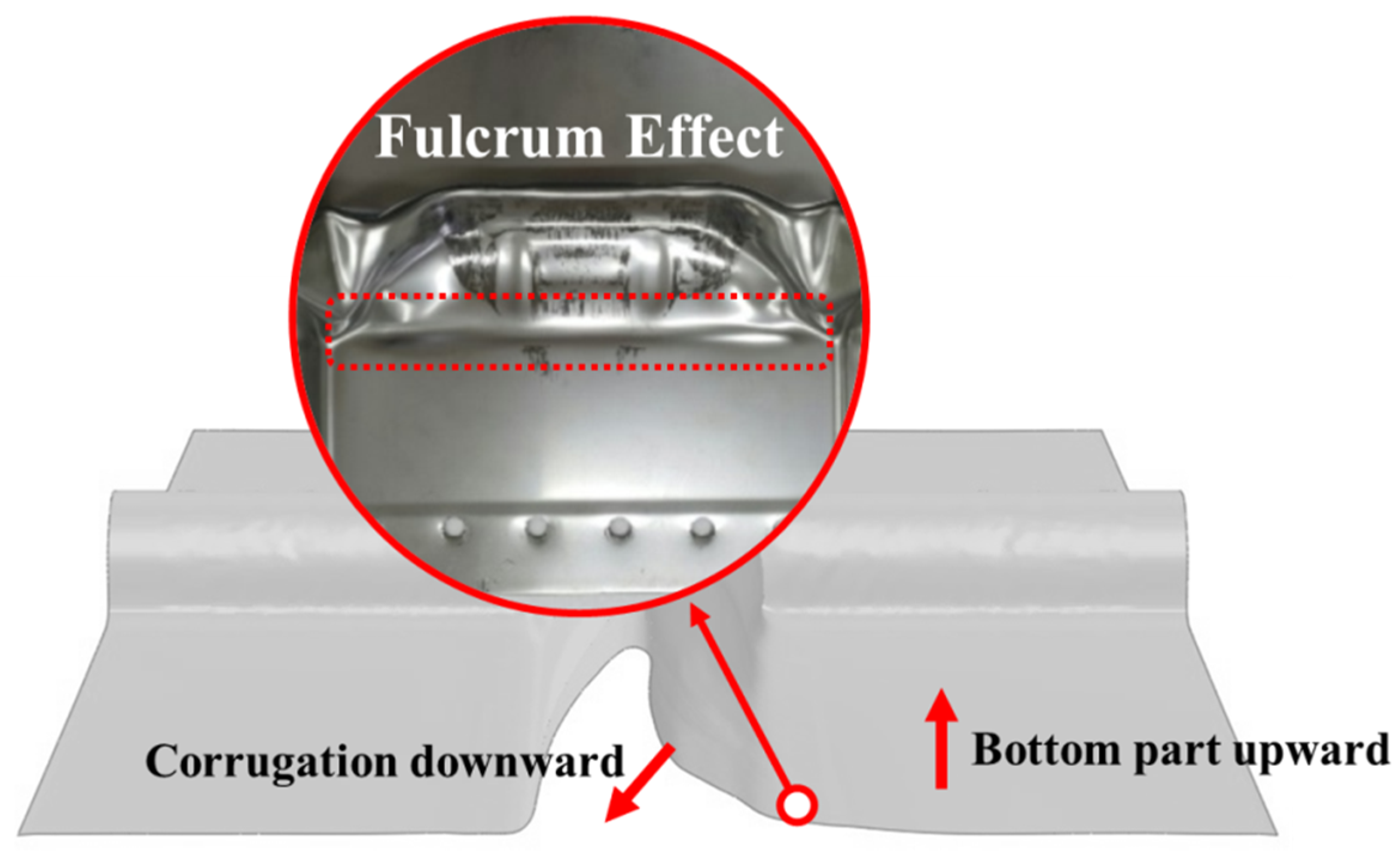
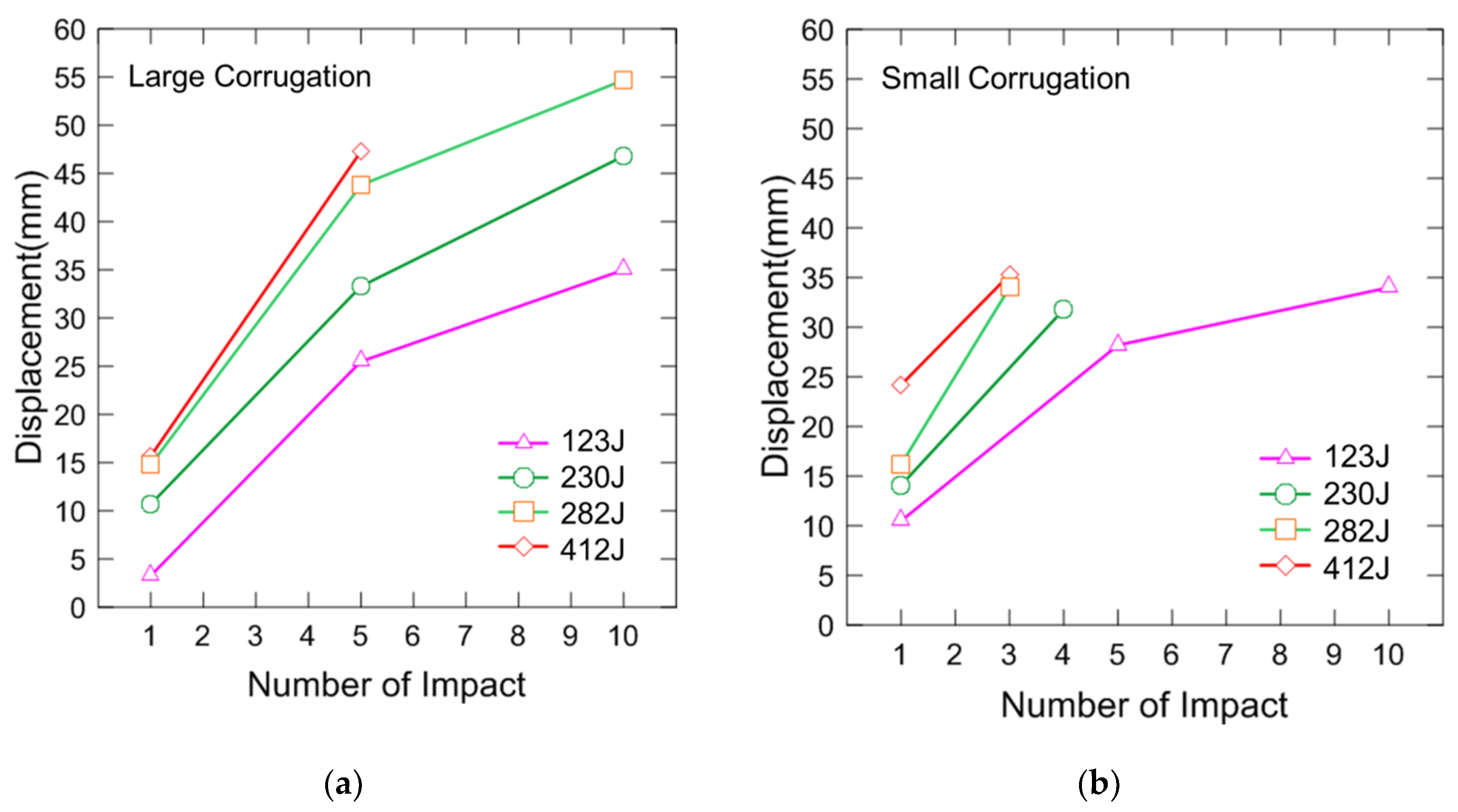
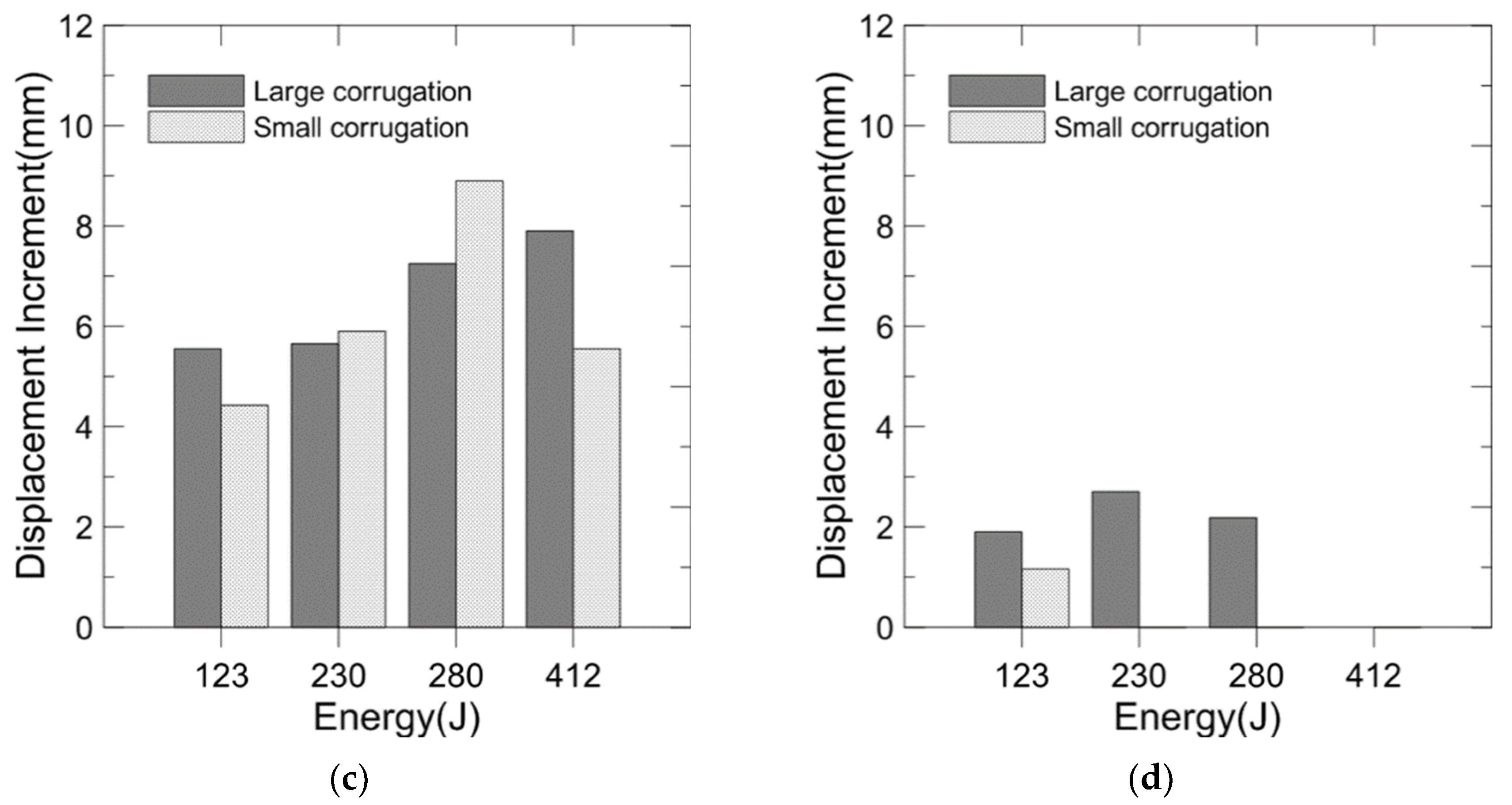
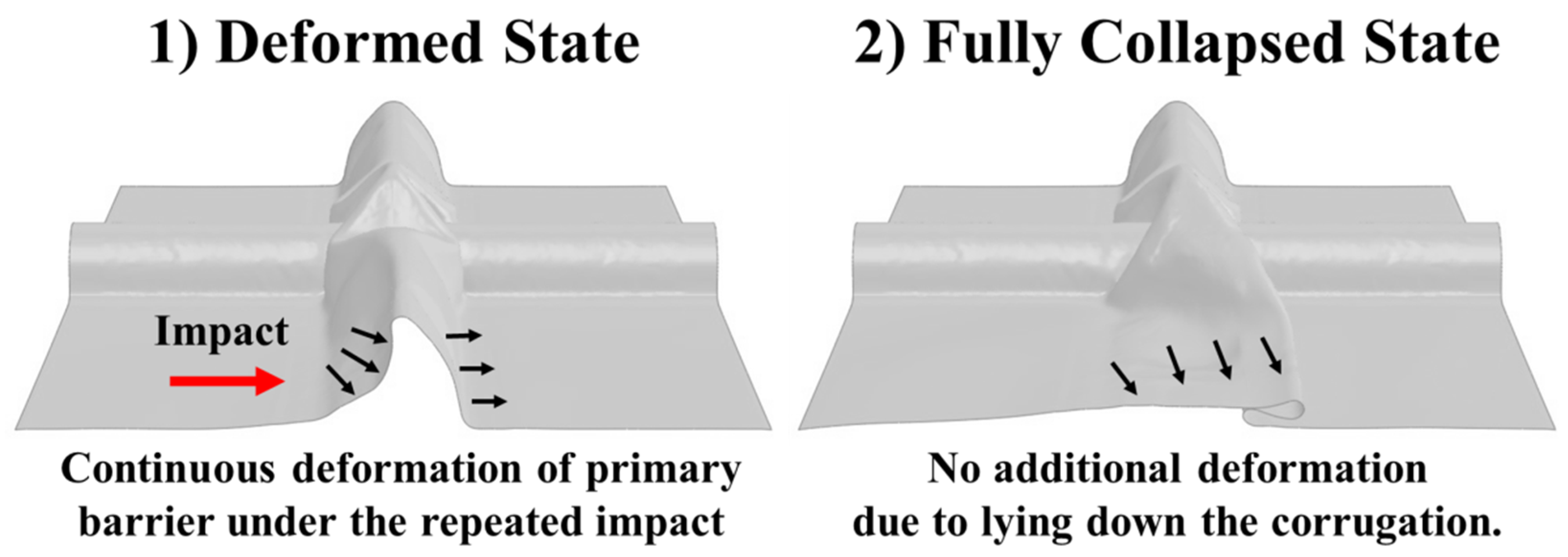
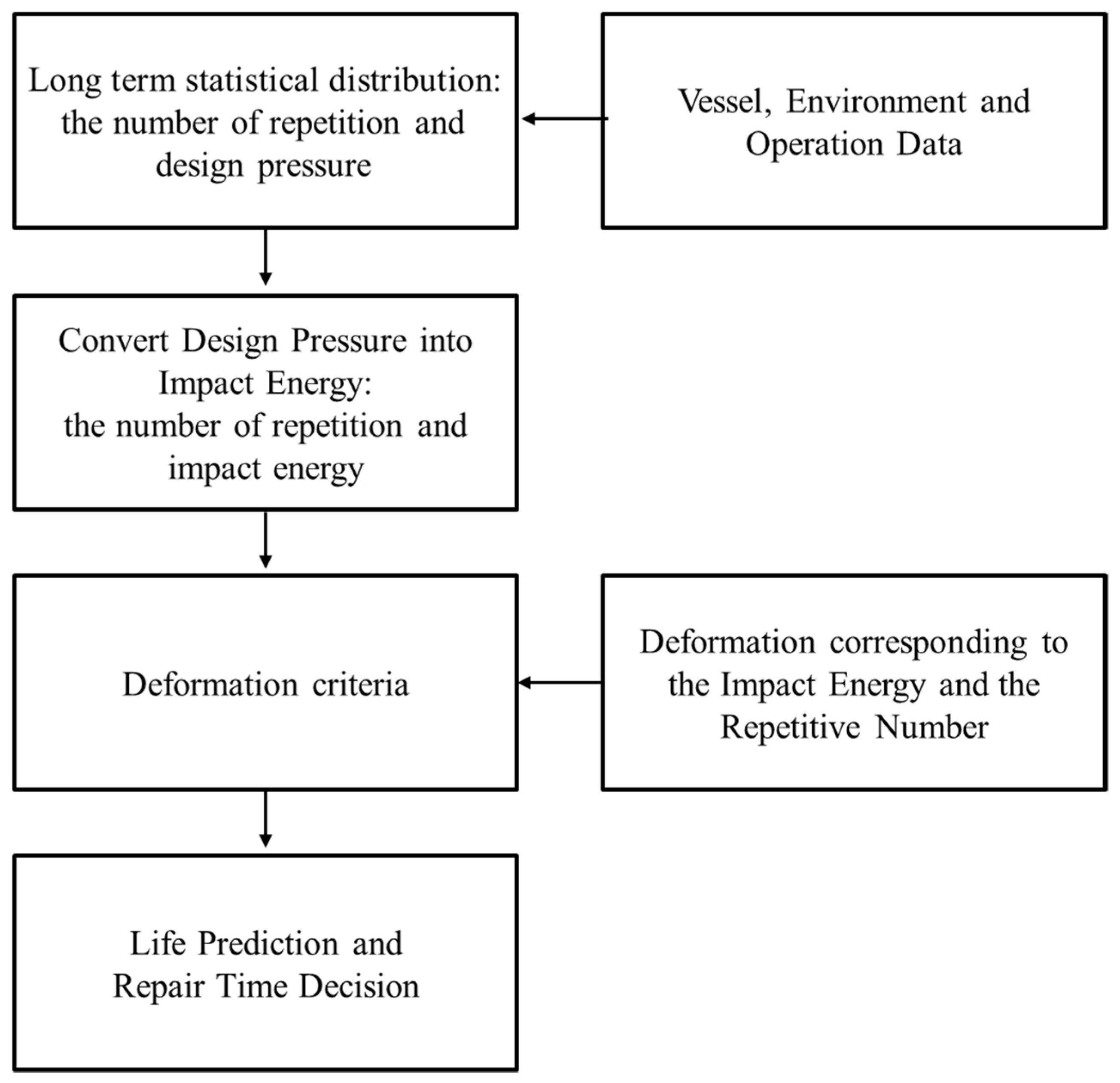
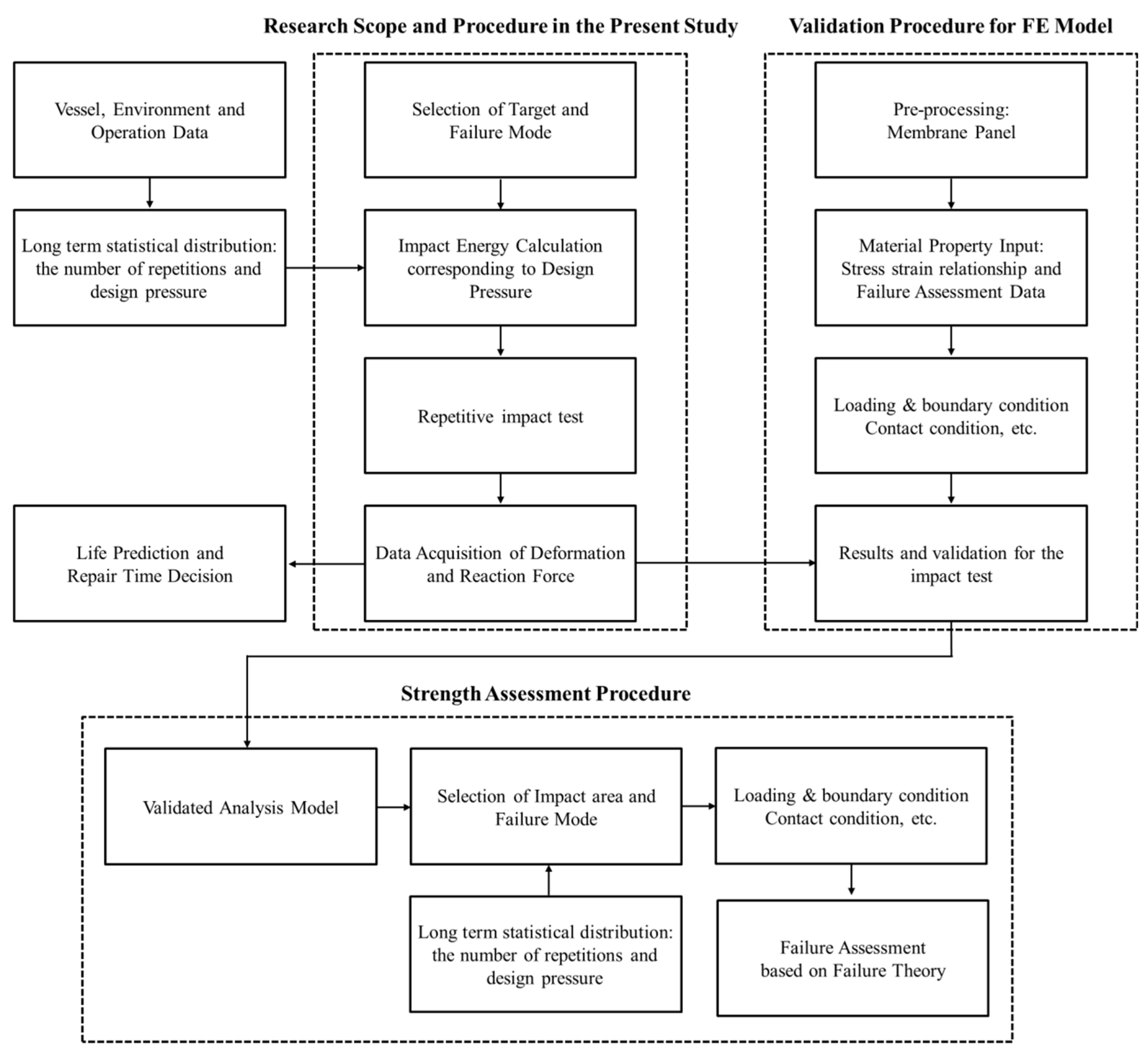
| Chemical Composition (%) | ||||||||
|---|---|---|---|---|---|---|---|---|
| C | Cr | Si | Cu | P | Mn | Ni | S | Mo |
| 0.016 | 18.2 | 0.376 | 0.5 | 0.028 | 1.451 | 8.63 | 0.0251 | 0.254 |
| No. | Peak Pressure (MPa) | Energy (J) | Drop Velocity (mm/s) | Drop Height (mm) |
|---|---|---|---|---|
| 1 | 0.88 | 123.3 | 851.5 | 38 |
| 2 | 1.52 | 230.3 | 1164.0 | 71 |
| 3 | 2.36 | 282.2 | 1128.5 | 87 |
| 4 | 2.78 | 412.0 | 1556.7 | 127 |
| Scenario Name | Specimen Type | Impact Energy (J) | The Number of Repeated Loading |
|---|---|---|---|
| L123 | Large corrugation | 123.3 | 10 |
| L230 | 230.3 | 10 | |
| L282 | 282.2 | 10 | |
| L412 | 412.0 | 5 | |
| S123 | Small corrugation | 123.3 | 10 |
| S230 | 230.3 | 4 | |
| S282 | 282.2 | 3 | |
| S412 | 412.0 | 3 |
| Duration (ms) | Rise Time (ms) | Rise Time/Duration | ||||
|---|---|---|---|---|---|---|
| Mean | STD | Mean | STD | Mean | STD | |
| Exp. result | 37.7 | 108.2 | 19.4 | 75.9 | 0.510 | 0.021 |
| Graczyk and Moan, 2008 | 27.4 | 41.0 | 11.4 | 17.6 | 0.480 | 0.200 |
© 2019 by the authors. Licensee MDPI, Basel, Switzerland. This article is an open access article distributed under the terms and conditions of the Creative Commons Attribution (CC BY) license (http://creativecommons.org/licenses/by/4.0/).
Share and Cite
Kim, M.-S.; Kim, J.-H.; Kim, S.-K.; Lee, J.-M. Experimental Investigation of Structural Response of Corrugated Steel Sheet Subjected to Repeated Impact Loading: Performance of LNG Cargo Containment System. Appl. Sci. 2019, 9, 1558. https://doi.org/10.3390/app9081558
Kim M-S, Kim J-H, Kim S-K, Lee J-M. Experimental Investigation of Structural Response of Corrugated Steel Sheet Subjected to Repeated Impact Loading: Performance of LNG Cargo Containment System. Applied Sciences. 2019; 9(8):1558. https://doi.org/10.3390/app9081558
Chicago/Turabian StyleKim, Myung-Sung, Jeong-Hyeon Kim, Seul-Kee Kim, and Jae-Myung Lee. 2019. "Experimental Investigation of Structural Response of Corrugated Steel Sheet Subjected to Repeated Impact Loading: Performance of LNG Cargo Containment System" Applied Sciences 9, no. 8: 1558. https://doi.org/10.3390/app9081558
APA StyleKim, M.-S., Kim, J.-H., Kim, S.-K., & Lee, J.-M. (2019). Experimental Investigation of Structural Response of Corrugated Steel Sheet Subjected to Repeated Impact Loading: Performance of LNG Cargo Containment System. Applied Sciences, 9(8), 1558. https://doi.org/10.3390/app9081558





